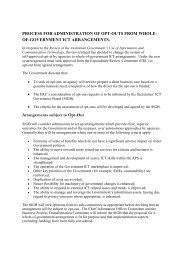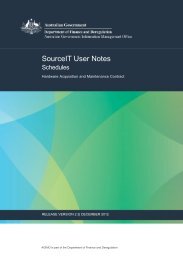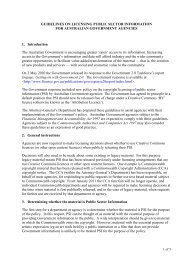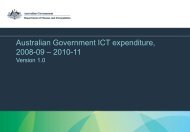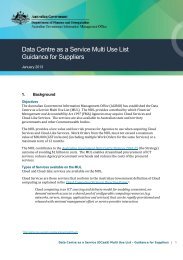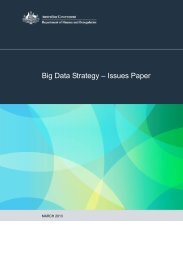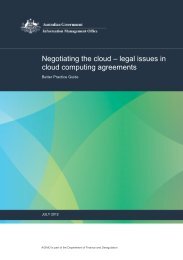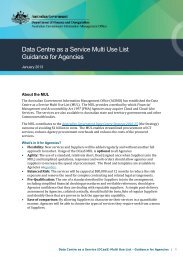APS ICT Strategy 2012 - Australian Government Information and ...
APS ICT Strategy 2012 - Australian Government Information and ...
APS ICT Strategy 2012 - Australian Government Information and ...
You also want an ePaper? Increase the reach of your titles
YUMPU automatically turns print PDFs into web optimized ePapers that Google loves.
Executive summary<br />
The global connectedness arising from technology creates opportunities for Australia’s<br />
participation in new economies, to be a leader in exploiting technology for national growth<br />
through the NBN <strong>and</strong> to be a preferred destination for new enterprises.<br />
The <strong>Strategy</strong> identifies actions to be taken between <strong>2012</strong> <strong>and</strong> 2015 to continue the release of<br />
government data for wider use, to share information <strong>and</strong> knowledge resources <strong>and</strong> unlock further<br />
economic <strong>and</strong> social value.<br />
Priority areas<br />
To increase productivity, the <strong>Strategy</strong> identifies strategic actions in three priority areas. These are:<br />
1. Deliver better services—more effective use of <strong>ICT</strong> delivers improved productivity <strong>and</strong><br />
streamlined, high quality government services that are personalised, easy-to-use <strong>and</strong> can be<br />
linked to other services. To realise this outcome we are:<br />
. building capability—improving <strong>ICT</strong> knowledge, skills <strong>and</strong> capacity across the <strong>APS</strong> to<br />
deliver more efficient, effective <strong>and</strong> improved services<br />
. improving services—using <strong>ICT</strong> to simplify <strong>and</strong> join together services that government<br />
provides to individuals <strong>and</strong> businesses, while ensuring security <strong>and</strong> privacy.<br />
2. Improve the efficiency of government operations—more innovative <strong>and</strong> strategic use of <strong>ICT</strong><br />
ensures greater value <strong>and</strong> more effective policy delivery that takes advantage of technologyenabled<br />
opportunities. To realise this outcome we are:<br />
. investing optimally—targeting <strong>and</strong> coordinating <strong>ICT</strong> investment <strong>and</strong> sharing resources<br />
<strong>and</strong> services to deliver the greatest value <strong>and</strong> improve efficiency <strong>and</strong> effectiveness<br />
. encouraging innovation—harnessing the full potential of the digital economy <strong>and</strong><br />
new technologies to promote innovative ideas <strong>and</strong> take-up of technology-enabled<br />
improvements.<br />
3. Engage openly—more active involvement of all stakeholders builds knowledge, sparks ideas<br />
<strong>and</strong> growth, <strong>and</strong> better informs decisions <strong>and</strong> solutions that meet local needs. To realise this<br />
outcome we are:<br />
. creating knowledge—generating, sharing, managing <strong>and</strong> more effectively using<br />
information to improve decision-making, drive economic growth <strong>and</strong> tailor services <strong>and</strong><br />
policies to local needs<br />
. collaborating effectively—strengthening networks, creating partnerships <strong>and</strong> using<br />
a variety of technologies to involve the wider community in developing policy <strong>and</strong><br />
informing service delivery.<br />
6<br />
<strong>Australian</strong> Public Service <strong>Information</strong> <strong>and</strong> Communications Technology <strong>Strategy</strong> <strong>2012</strong>-2015



